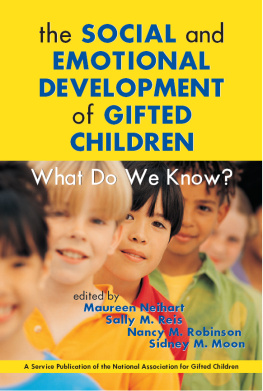


Copyright 2018, Prufrock Press Inc.
Edited by Stephanie McCauley
Cover and layout design by Raquel Trevino
ISBN-13: 978-1-61821-671-7
No part of this book may be reproduced, translated, stored in a retrieval system, or transmitted, in any form or by any means, electronic, mechanical, photocopying, microfilming, recording, or otherwise, without written permission from the publisher.
For more information about our copyright policy or to request reprint permissions, visit http://www.prufrock.com/permissions.
At the time of this books publication, all facts and figures cited are the most current available; all telephone numbers, addresses, and website URLs are accurate and active; all publications, organizations, websites, and other resources exist as described in this book; and all have been verified. The authors and Prufrock Press make no warranty or guarantee concerning the information and materials given out by organizations or content found at websites, and we are not responsible for any changes that occur after this books publication. If you find an error or believe that a resource listed here is not as described, please contact Prufrock Press.

| Prufrock Press Inc.
P.O. Box 8813
Waco, TX 76714-8813
Phone: (800) 998-2208
Fax: (800) 240-0333
http://www.prufrock.com |

Table of Contents

FOREWORD
An Inspiring, Insightful, Practical Excursion Through Difficult Social-Emotional Phenomena
____________________________
Don Ambrose
If you read only one book this year, make sure its this one. Having been immersed in the field for a long time, and having worked with gifted young people in diverse roles and locales, my default inclination is to assume that there isnt much more I can learn about the social-emotional dynamics of giftedness and talent development. But the light bulb kept flicking on as I moved through this book. Im sure this will happen with all readers.
I consider it an honor to write the foreword for this important book authored by Tracy Cross, a scholar whose insightful work consistently informs and invigorates the field of gifted education. Social and emotional development has been an increasingly hot topic in the field for some time now. Scholars and practitioners have been recognizing these important dimensions of the whole child because prominent voices in the field have been pushing those dimensions to the forefront of our attention. Tracy has been a most important voice in this regard. His prior work, embedded in a large number of impressive, groundbreaking articles and books, has been magnifying the social and emotional aspects of giftedness, ensuring that researchers take them into account in their inquiries and practitioners pay attention to them in their programs and classrooms. The inspiration for this book largely comes from the collection of insightful articles Tracy wrote for Gifted Child Today (GCT), and he has augmented that body of work with additional ideas and research findings.
One of the many helpful organizational features in the book is Tracys Continuum of Psychological Services, which pulls together advising, guidance, counseling therapy, and psychopharmacology. The continuum helps professionals and parents avoid making mistakes such as addressing the wrong problem, acting overzealously, tripping over one another, and more. As is the case with most of Tracys work, he follows this valuable conceptual framework by situating the in-depth, detailed analyses to come within explorations of the nature of giftedness in the first chapter. After establishing the big picture conceptual framework for the volume and providing the research-based building blocks, he then goes on to provide comprehensive, detailed portrayals of practical strategies that can be used to help gifted young people who are dealing with difficult situations and circumstances.
Other strengths in the volume come from Tracys ability to combine his rich, practical experiences in various roles over the years with his inclination to draw insights from multiple academic disciplines and professional fields. The National Science Foundation has been magnifying the importance of interdisciplinary work (see Suresh, 2013), so Tracys interdisciplinary syntheses put this book at the forefront of a growing, 21st-century professional knowledge wave.
Anyone who has enjoyed the privilege of discussions with Tracy on complex topics will recognize and appreciate his writing style in this book. He has a penchant for simplifying the complex, distilling it down to its essence, while preserving all of the important elements. Readers will find this an easily accessible, compelling excursion through the multiple dimensions of giftedness, talent development, psychological tensions, ethical dilemmas, and much more.
One reason he is able to make the complex simple comes from an aspect of the work in this book that I find helpful and inspiring. During my interdisciplinary explorations, I keep coming across examples of scholars and professionals who lock themselves into one level of analysis or another. Ive come to appreciate that there are four levels of analysis organizing the work in a domain or professional fieldthe levels of practice, research, theory, and philosophical analysis (see Ambrose, VanTassel-Baska, Coleman, & Cross, 2010). Think of these as levels of elevation covering the conceptual landscape of a field. In gifted education, for example, practitioners work at the ground level planting and nurturing the seeds of learning. At the next level of elevation, researchers are surveyors mapping the conceptual terrain. Higher up on the terrain, theorists lead groups of practitioners and researchers over elevated conceptual barriers into new theoretical valleys. And philosophical analysts climb conceptual mountain peaks to gain panoramic views of patterns in the conceptual territory. As one moves down to the ground level, the perspective becomes detail-rich but lacking in panoramic vision. Conversely, as one moves up toward the philosophical level, the panoramic vision of more conceptual territory becomes visible, but at the expense of important, practical detail. In order to understand a field comprehensively we need all four levels of analysis working together, informing one another. A scholar or professional who becomes locked dogmatically into one level might do proficient work in that level but end up causing harm to the field by pushing it down a counterproductive or increasingly barren path. For example, one can argue that excessive attention to hyper-mechanistic research in psychology pushed that discipline down the increasingly barren behaviorist path for a considerable length of time in the mid-late 20th century. Had more of the influential psychologists of the time been able to telescope upward and downward through these four levels of analysis, they would have been able to emphasize other psychological phenomena sooner and move the field forward more vigorously and accurately (for details on this and other forms of dogmatic scholarly work, see Ambrose & Sternberg, 2012; Ambrose, Sternberg, & Sriraman, 2012). Fortunately, Tracy has been one of the best telescopers Ive ever confronted in academia. He can navigate through the detail-rich, practical level and connect it with all of the other levels up into the philosophical mountaintops of the field. Very few academicians are capable of this kind of conceptual exploration, so this book is a rare, perfect example of extremely rich, productive conceptual telescoping. It provides scores of examples of clear, practical ideas and strategies from the ground level, while situating them within panoramic perspectives on the field.
Next page






















